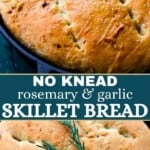This quick and easy no-knead skillet bread recipe is the perfect intro recipe for those of you looking to start your bread-baking journey. It’s super low maintenance and turns out wonderfully crusty bread with subtle hints of rosemary and garlic. Who’s hungry?
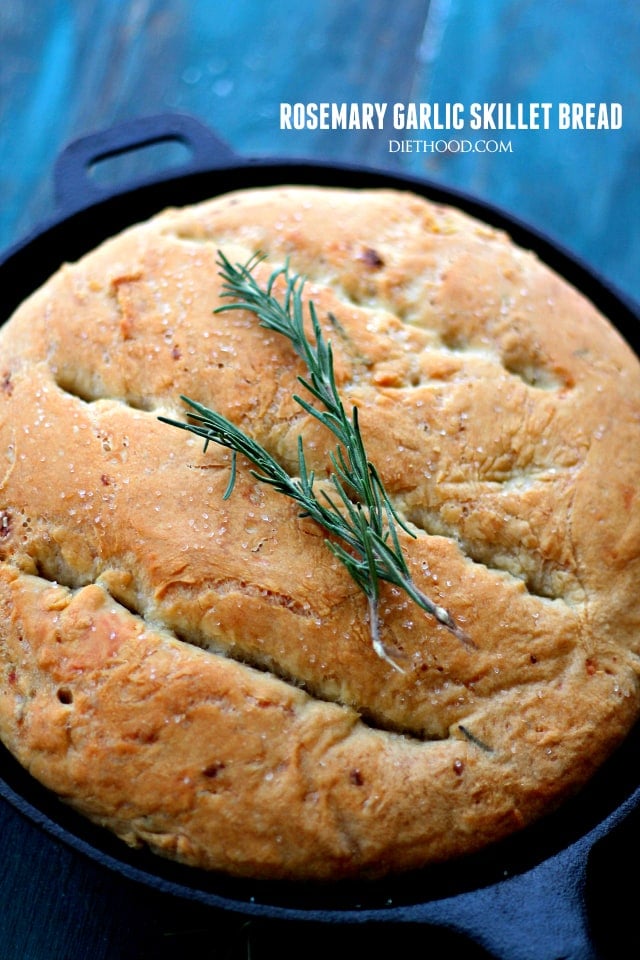
Do you dream of warm, flavorful homemade bread but have no idea where to start? That was me several years ago until I found a recipe for an artisan bread that didn’t need kneading! I couldn’t wait to start because as you know, no bread tastes as good as homemade bread.
This beginner-friendly no knead skillet bread is the recipe for you. Forget the hassle and guesswork that goes into kneading bread dough. Just mix everything together, let the dough rise a couple of times, and bake. That’s it! You’ll have the perfect rosemary garlic loaf. It’s fluffy on the inside with the perfect, crisp crust.
Why You’ll Love This Skillet Bread Recipe
No-knead, no problem. This bread is so much less of a headache to make than other yeasted breads. You don’t even have to knead it, which cuts your prep time down quite a bit and takes some of the guesswork out of the process. It’s the perfect recipe for those of you who are newer to bread baking and/or short on time.
Texture. Baking this bread in the skillet ensures that the bread develops a wonderfully crisp, crunchy crust while maintaining fluffy and soft on the inside. It’s bread heaven.
Flavorful additions. This loaf is extra special because it is infused with subtle hints of rosemary and garlic. It smells so good as it bakes and tastes even better!
What You’ll Need
You won’t need much to make skillet garlic bread – you might already have everything you need at home! Here’s a checklist for you. You’ll find precise measurements in the recipe card below.
- Lukewarm water – The water should be warm enough to activate the yeast but not too hot. If it is too hot, it will kill the yeast and your bread won’t rise.
- Active dry yeast – Make sure your yeast is fresh. An opened container of active dry yeast will stay good in the fridge for 4-6 months. If your yeast has been in the fridge for longer than that or if it has been left out at room temperature for too long after being opened, it won’t give you the proper rise.
- Kosher salt
- All-purpose flour – Gluten-free or whole wheat flour will work but the texture will be a little different.
- Fresh rosemary leaves – Feel free to experiment with other fresh herbs. Thyme and/or oregano could be fun.
- Garlic – I like to use fresh garlic, but 1/2 teaspoon of garlic powder is a good substitute.
- Olive oil – I encourage you to use high-quality extra virgin olive oil. I prefer younger olive oils for this bread.
- Sea salt – It’s the perfect addition. I love the way the little salt crystals look on top of this loaf. They enhance the flavor, too.
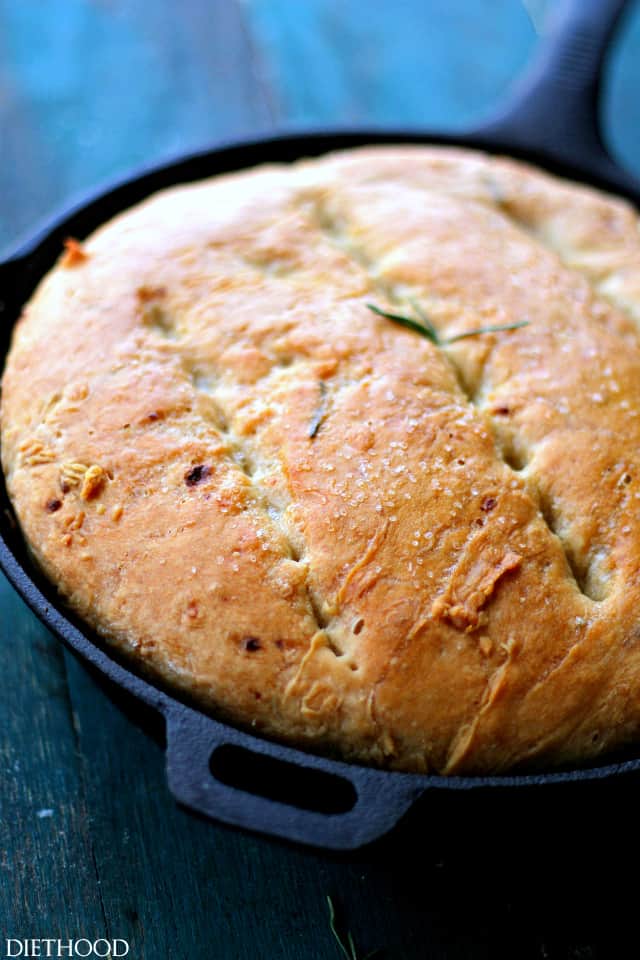
How To Make No Knead Skillet Bread
Take a look at my quick overview of how to make skillet bread with this easy-to-follow recipe. Just combine the ingredients, let the dough rise, and bake it in a cast iron skillet for a deliciously rustic loaf.
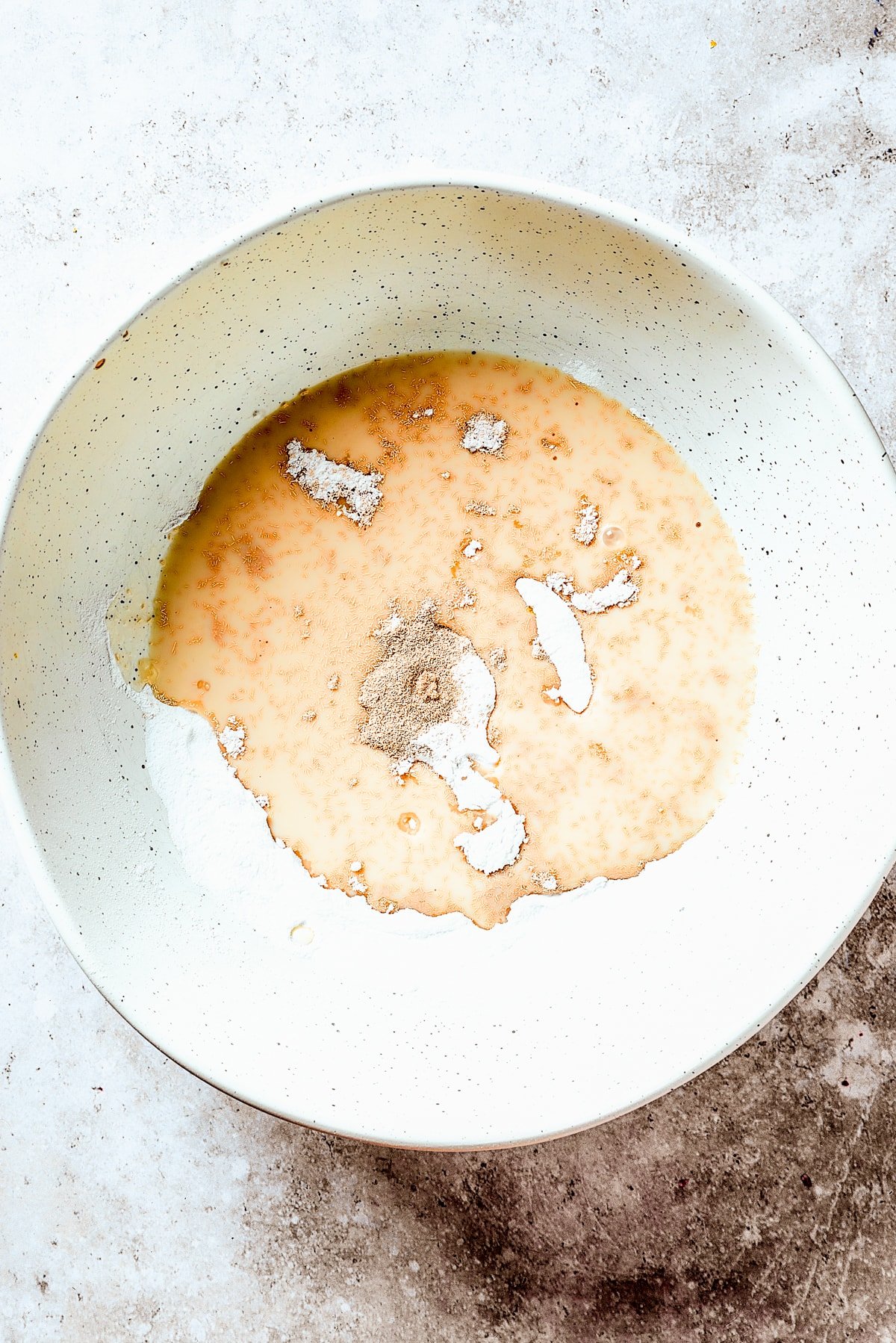
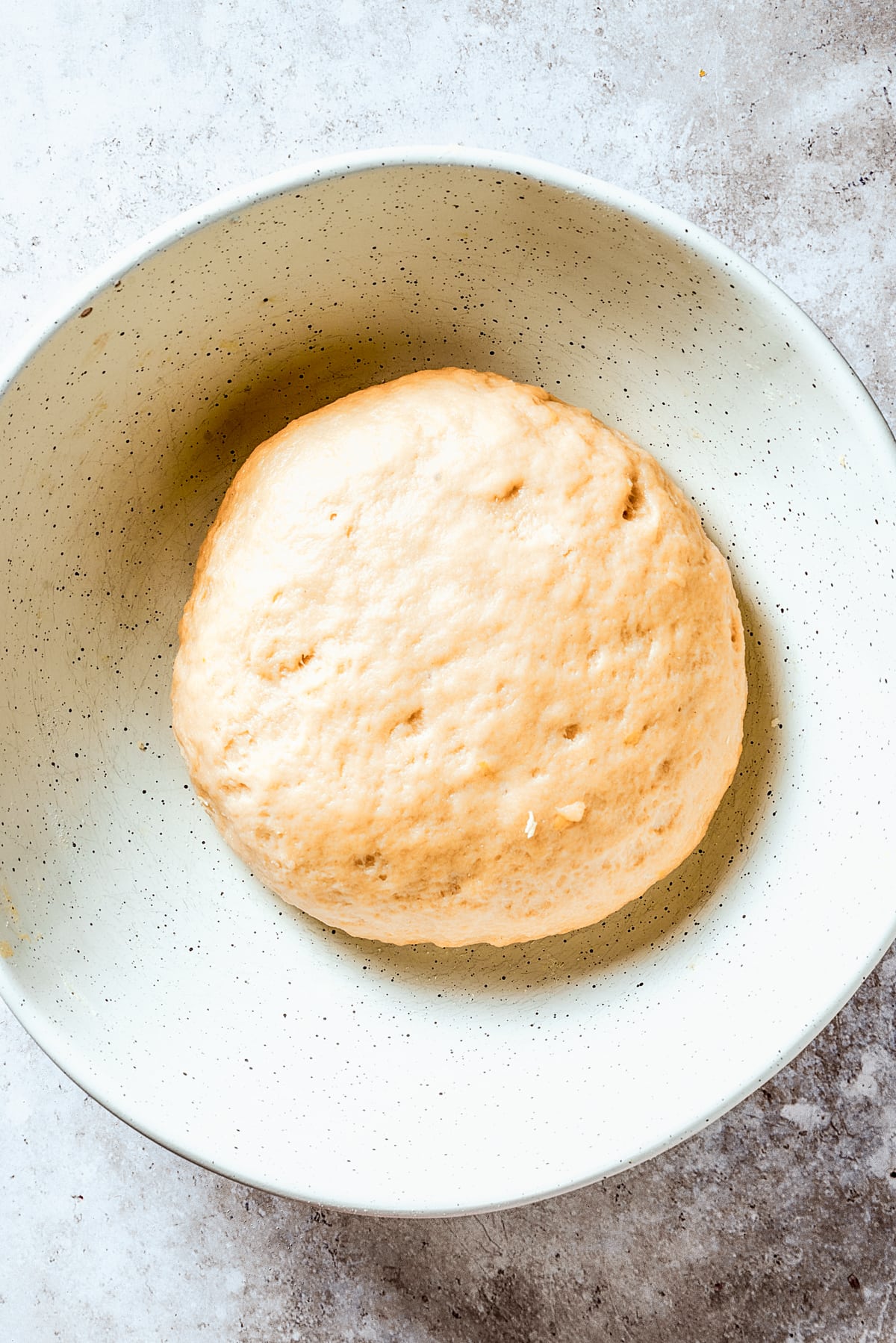

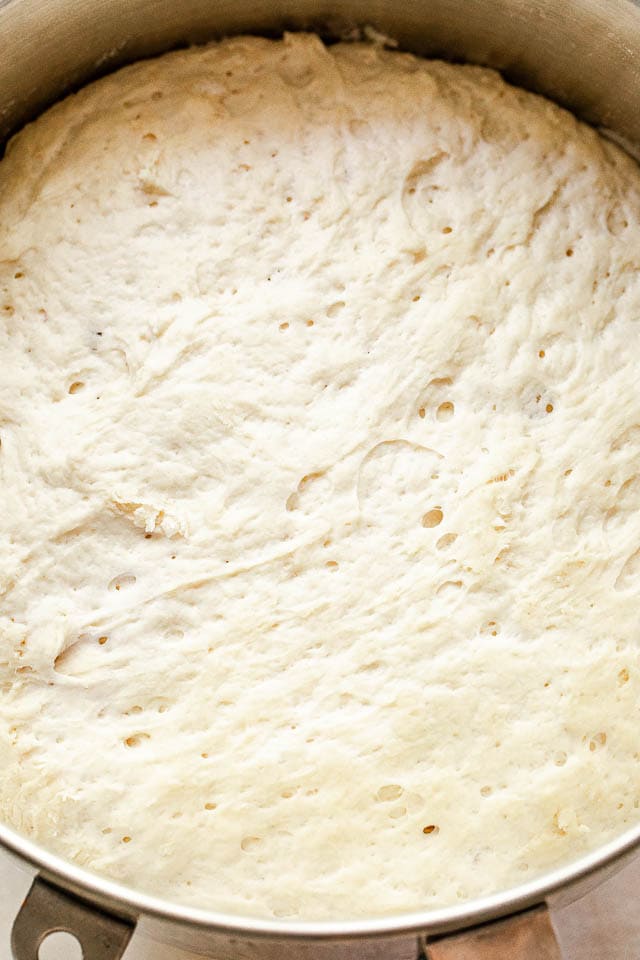
- Make the dough. Combine the water and yeast in a large bowl and mix in 1 cup of flour and the kosher salt. Stir in the rosemary and garlic followed by the remaining flour, 1 cup at a time.
- First rise. Cover the dough with plastic wrap and let it rise in a warm place for 1 hour.
- Oil the skillet. Grease a cast iron skillet with 1 tablespoon of olive oil.
- Second rise. Using floured hands, transfer the dough to the skillet and shape it into a disk. Cover with a kitchen towel and let rise for 30 minutes.
- Prep. Preheat the oven to 400˚F.
- Bake. Remove the kitchen towel from the dough, drizzle with the remaining olive oil, and sprinkle with sea salt. Score the top of the dough and bake for 30-35 minutes.
- Cool. Turn the bread out onto a cooling rack and cool for 1 hour before slicing and serving.

Recipe Tips
- Temperature matters. The water should be lukewarm (about 105˚F). If it is too cold, it won’t activate the yeast properly. On the other hand, if it is too hot, it will kill the yeast.
- Use a cast iron skillet. The skillet is essential for this recipe. It provides the perfect heat distribution for a crisp crust. Other pans may not yield the same results.
- Grease the skillet. Make sure you grease the skillet liberally. Otherwise, the bread will stick.
- Rise in a warm environment. The dough won’t rise properly if it is too cold, so let it rise in nice warm place.
- Use an oven thermometer. This bread does best if baked as close to 400°F as possible. Ovens are notorious for having faulty thermostats. I encourage you to use an oven thermometer to make sure your oven is cooking at the right temperature.
- Remove the bread from the skillet. As soon as it comes out of the oven, turn the bread out onto a cooling rack. If it’s left in the pan, it will become soggy.
- Let it cool. Allow the bread to cool for at least one hour before slicing it to achieve the best texture.
Fun Variations
This no knead skillet bread recipe is pretty flexible, but consider using different herbs. Instead of rosemary, consider using fresh thyme or oregano. Sage would be interesting as well. You can keep the garlic in there or leave it out. You could also make it cheesy! I will sometimes fold some freshly grated parmesan or pecorino cheese into my bread dough. Shredded cheddar, too.
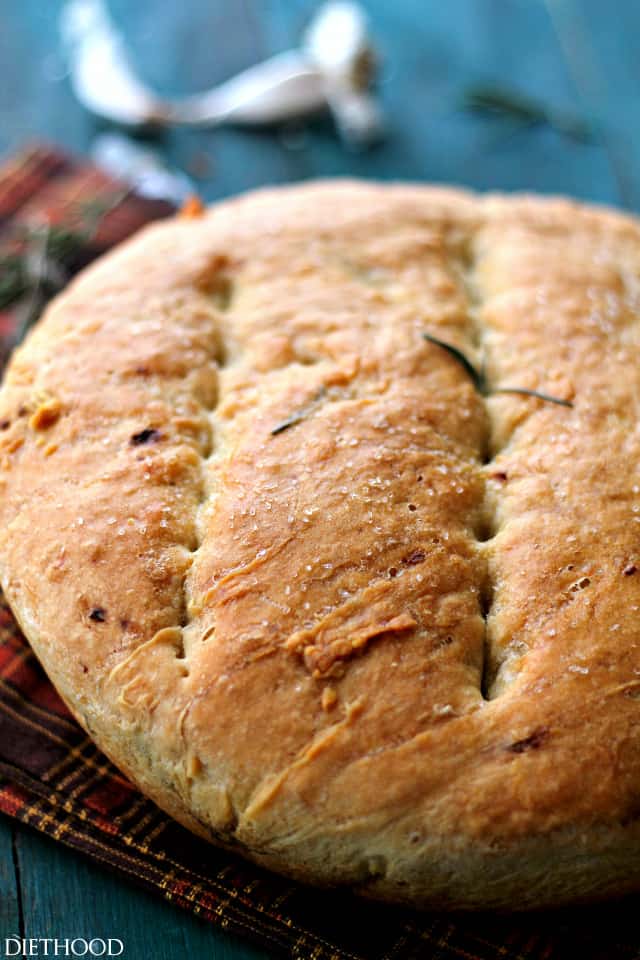
Serving Suggestions
To me, there is not much better than a fresh, warm slice of homemade bread with a pad of salted butter. If you’re feeling adventurous, spread a bit of jam on top as well for a sweet-savory approach. My Homemade Strawberry Jam or this Plum Cardamom Jam would be amazing.
Skillet garlic bread is good pretty much any time of day. Enjoy it with Sheet Pan Eggs for breakfast, as the vessel for Chicken Salad for lunch, or alongside a savory dinner. I love using it to sop up the sauce from this Crockpot Lasagna.
Proper Storage
Keep your fully cooled bread fresh by storing it in a bread box or wrapping it in a clean cloth inside a plastic bag. For longer storage, you can slice, and freeze in an airtight container for up to 3 months.
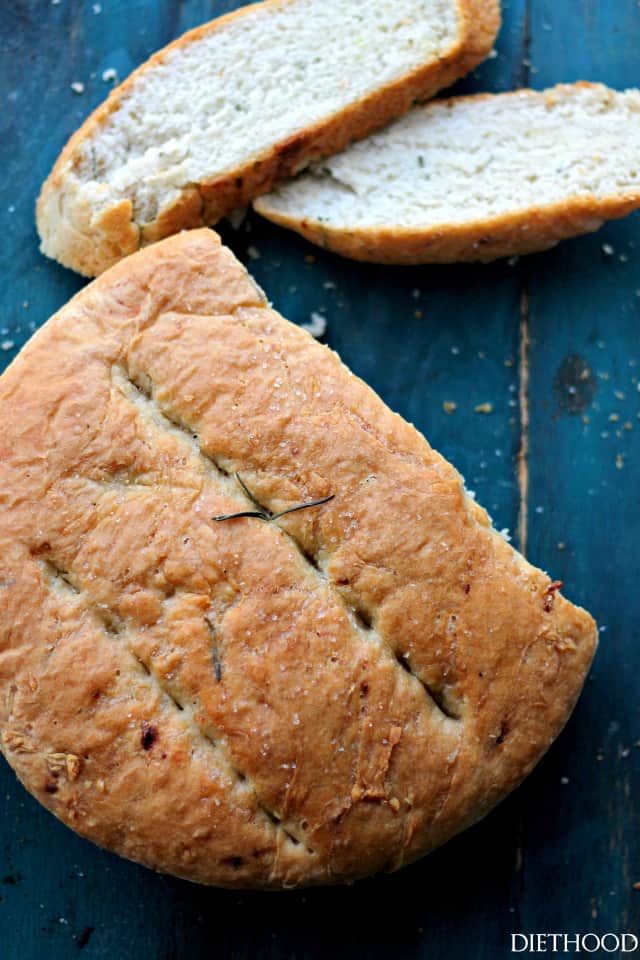
More Easy Bread Recipes
There’s something so wholesome and satisfying about making your own bread. If this rosemary skillet bread got you inspired, I’d bet my bottom dollar you’ll love these recipes too.
-
In a large mixing bowl, combine the water and yeast. Add 1 cup of flour and salt and stir with a wooden spoon until combined.
-
Stir in the rosemary leaves and minced garlic. Add remaining flour, one cup at a time, stirring until thoroughly combined.
-
Cover with plastic wrap and set in a warm spot to rise for 1 hour.
-
Add a tablespoon of olive oil in an 8 or 10-inch cast iron skillet; using a napkin or your fingers, coat the bottom and sides of the skillet with the olive oil.
-
Flour your hands. Remove the plastic wrap and using your hands, transfer the dough to the prepared skillet and shape it into a disk.
-
Cover with a kitchen towel and let rise for 30 minutes.
-
Preheat the oven to 400˚F.
-
Remove the kitchen towel, drizzle the remaining olive oil over the top, and sprinkle the dough with sea salt.
-
Score the top of the dough with some shallow knife cuts.
-
Bake for 30 to 35 minutes or until the top is nicely browned.
-
Remove from oven and turn the bread out onto a wire cooling rack.
-
Let the bread cool for 1 hour or so before you cut into it. Letting it cool down sets the texture and keeps it fresh for longer.
-
Cut and serve.
- Warm Water: Lukewarm water is about 105˚F. If you don’t have a thermometer, feel it with your fingers; it should be warm but not hot. Remember that if the water reaches temperatures of 120°F or more, the yeast will begin to die off.
- Flour: This bread recipe was made with all-purpose flour. I haven’t tried it with bread flour or any other varieties.
- Variations: Substitute the rosemary and garlic with other herbs or add crumbled or shredded cheeses for different flavor profiles.
- Cast Iron Skillet: My go-to for baking these types of breads has always been a cast iron skillet. If you do not have a cast iron skillet, use a stoneware baking dish instead.
- Cooling: It is crucial to remove the bread from the skillet as soon as it comes out of the oven; bread left in the pan will get moist and soggy. Also, let the bread sit and cool for a solid hour before slicing it.
Serving: 1 slice | Calories: 224 kcal | Carbohydrates: 42 g | Protein: 6 g | Fat: 3 g | Saturated Fat: 1 g | Polyunsaturated Fat: 1 g | Monounsaturated Fat: 2 g | Sodium: 350 mg | Potassium: 64 mg | Fiber: 2 g | Sugar: 1 g | Vitamin A: 12 IU | Vitamin C: 1 mg | Calcium: 11 mg | Iron: 3 mg
Nutritional info is an estimate and provided as courtesy. Values may vary according to the ingredients and tools used. Please use your preferred nutritional calculator for more detailed info.


